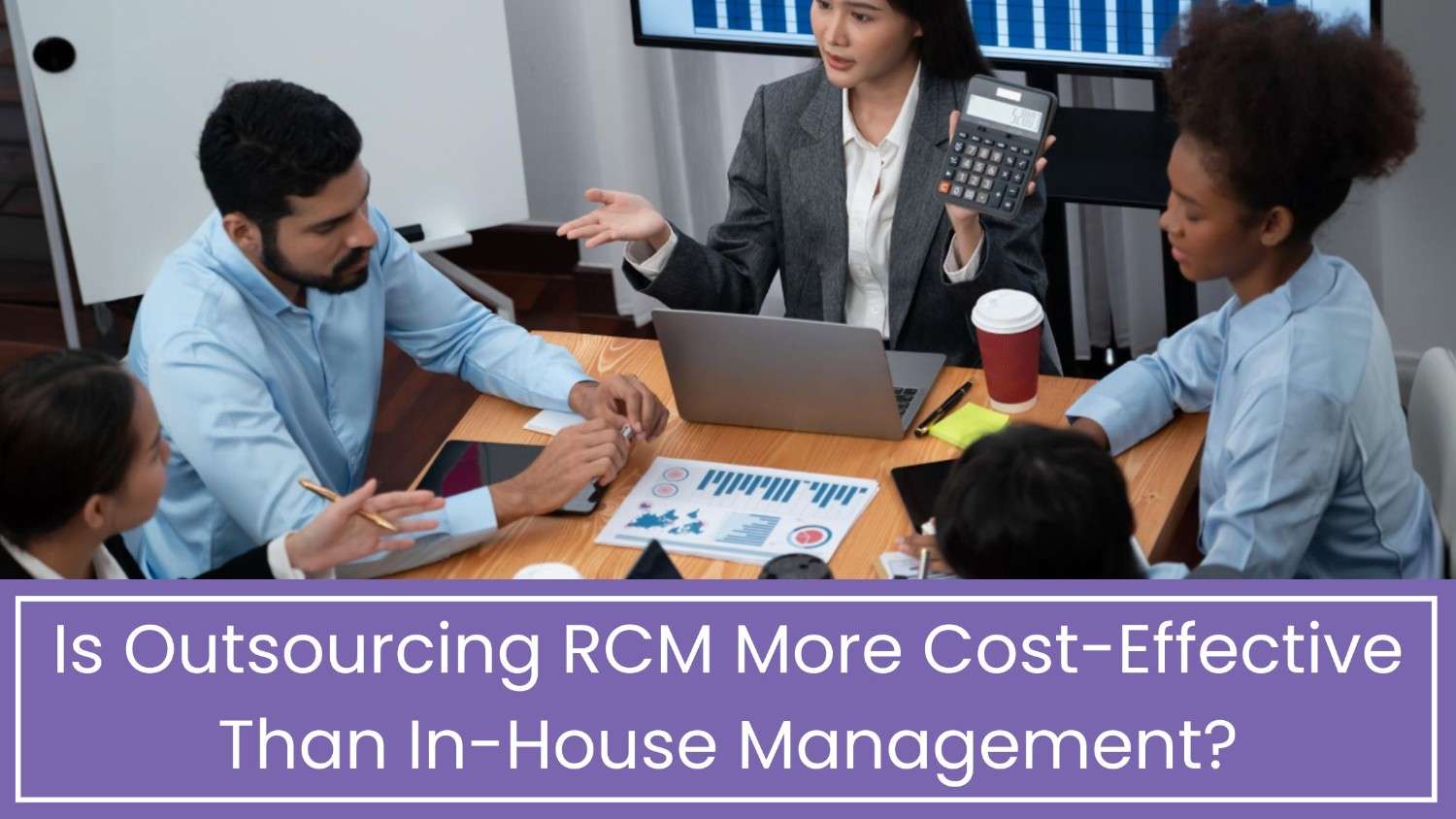Is Outsourcing RCM Cheaper Than In-House Billing
Is Outsourcing RCM Cheaper Than In-House Billing? This blog explores the true financial impact, hidden expenses, and real costs of both approaches. We analyze the risks linked to salaries, software, compliance, and claim denials while explaining how outsourcing enhances cash flow, reduces errors, and cuts costs. Discover 2025 trends, real-world data, and best practices to make the most informed decision for your medical practice. Learn how partnering with experienced RCM experts like Practolytics can help you scale operations, boost revenue, and reduce denials—without the expense of maintaining an internal billing team.
Table of Contents
Is Outsourcing RCM More Cost-Effective Than In-House Management?
Every healthcare practice must choose: manage billing in-house or hire an outside expert? This choice affects your cash flow, claim approvals, patient happiness, and team workload.
At first, handling billing internally looks cheaper. Your team knows your patients and systems. But rules change, insurers demand more, and tech gets complex. Many practices now find that outsourcing saves money and works better long-term.
In this blog, we’ll compare both options. We’ll show real costs, 2025 trends, and data to help you pick what’s right for your practice.
Understanding RCM: Why It’s More Than Just Billing
Before we talk costs, let’s break down what Healthcare Revenue Cycle Management services really mean. Think of RCM as your financial backbone – it’s the full journey from when a patient books an appointment to when your practice gets paid.
Here’s what it covers step by step:
- Signing up patients and checking their coverage
- Coding visits and logging charges
- Sending claims and tracking them
- Handling denials and fixing claims
- Recording payments and billing patients
- Using reports to spot trends
Get any step wrong, and you face rejected claims, slow payments, or fines. RCM isn’t just paperwork – it’s a living system that keeps your cash flowing and your business healthy.
The True Cost of In-House RCM
On paper, doing your own medical billing might look cheaper. You have staff, space, and systems. But when you add up all costs—even hidden ones—the picture changes.
Direct Costs
- Salaries: Billers, coders, and managers need good pay.
- Benefits: Health care, time off, and extras add 20–30% more.
- Training: Staff must keep learning about rule changes.
- Software: Systems like EHR and billing tools cost a lot.
Indirect Costs
- Turnover: About 30% of billing staff leave yearly. Replacing them costs time and money.
- Errors: Mistakes lead to denied claims and lost revenue.
- Compliance Issues: Billing or privacy errors risk costly fines.
Key Insight: A 2024 study shows small practices spend $118k to $150k yearly just to manage billing—before counting revenue lost to denials.
The Economics of Outsourcing RCM
When you outsource RCM services, you hand off those tasks and costs to experts. RCM firms usually charge a share of what they collect for you (around 3-7%). They only earn when you get paid.
Why Outsourcing Saves Money
- Less Staff Cost: No salaries, benefits, or training to pay.
- Fewer Mistakes: Experts cut down on claim errors and denials.
- No Tech Costs: Most partners provide billing tools at no extra charge.
- Easy Growth: Handle more patients without hiring more people.
- Faster Cash: Pros know payer rules, so you get paid quicker.
- Real Results: Clinics using outsourced RCM often collect 10-25% more and see 20-30% fewer denials in year one.
Case Study: Cost Comparison Example
Let’s compare two medical practices. Both earn the same money and see the same patients.
Practice A: Oversees internal billing.
Three employees are working in billing, and their combined salaries come to $45,000, or $135,000.
- Benefits: an additional 25%, or $33,750
- $15,000 in software fees
- Ten thousand dollars for training and other costs
- The annual total comes to $193,750.
Practice B: Billing is outsourced
The cost is $150,000, or 5% of $3 million in yearly revenue.
- Software: Included
- Adherence to the law: Included
- Directions: Given
- Annual total cost: $150,000
Result: Outsourcing saves $43,750 per year.
Bonus: Practice B cuts claim denials by 25% and gets paid 18% faster.
The Real Value of Outsourcing
Saving money is important, but outsourcing offers other key benefits too.
- Better Patient Care
Your team spends less time on billing. This means more time for patients and better service.
- Expert Help On Demand
Outsourced teams handle many payers, specialties, and rules. Their know-how often beats in-house teams.
- Clear Data for Smarter Choices
Good vendors show claim trends, payer habits, and revenue patterns. Use these insights to guide your business.
- Quick Response to Changes
Rules and policies shift often. Outsourcing partners adapt fast to keep you current.
The Counterpoint: When In-House Still Makes Sense
While outsourcing saves money, some groups keep billing in-house:
- Big medical groups that can afford their own billing team.
- Practices with special insurance contracts needing custom steps.
- Organizations wanting full control over every billing detail.
Even then, many outsource tricky parts like denials or patient payments to work smarter.
2025 RCM Trends: Why Outsourcing Grows
Healthcare billing keeps changing. Here’s why outsourcing makes sense now:
More Complex Rules
New payment models and changing insurance rules make billing harder to handle alone.
Smarter Tech
Outsourcing partners use AI to catch errors and speed up claims—cutting costs and mistakes.
Staffing Gaps
Hiring skilled billers is tough. Outsourcing gives instant access to experts.
Remote Teams Deliver
More billing work happens from afar or overseas now. This saves money but keeps quality high.
Key Insight: Studies show healthcare outsourcing will grow 11.2% each year until 2030. Providers want better efficiency and savings.
Key Risks and How to Handle Them
Outsourcing has risks, but you can handle them well:
- Data Safety: Choose a partner who follows HIPAA rules and protects data strongly.
- Less Control: Meet often and watch how things are going.
- Slow Start: Plan a clear 30-60 day changeover.
Pick the right team and set clear targets from day one. You’ll lower risks and get better results.
Best Practices for Outsourcing RCM
To get the best value:
- Partner with a vendor experienced in your field.
- Set clear targets (like denial rates or payment turnaround times).
- Talk often—review performance monthly.
- Keep key tasks like patient eligibility checks in-house.
- Test with a short trial before signing long-term.
Conclusion: Outsourcing — A Smarter, Cost-Saving Strategy for Most Practices
The idea that doing billing in-house saves money is old thinking. When you add up staff costs, training, tech updates, and lost income from denied claims, outsourcing often costs less overall and gives better results.
Outsourcing also means faster payments, useful data, flexible support, and more time for patients. As rules get tougher, working with an expert RCM partner isn’t just smart—it’s how you stay ahead.
Ready for a change? Try Practolytics.
If you’re thinking about outsourcing, Practolytics makes it easy and affordable. With full RCM services, clear data, and proven results, we help you:
- Cut denials by up to 30%
- Boost collections by 15–25%
- Shrink A/R days
- Grow without hiring
Save money, reduce stress, and grow revenue. Talk to Practolytics today—see how outsourcing lifts your finances.
ALSO READ – Essential Tips for Error-Free Orthopedic Billing and Coding: Boost Your Practice’s Financial Health
Talk to Medical Billing Expert Today — Get a Free Demo Now!






